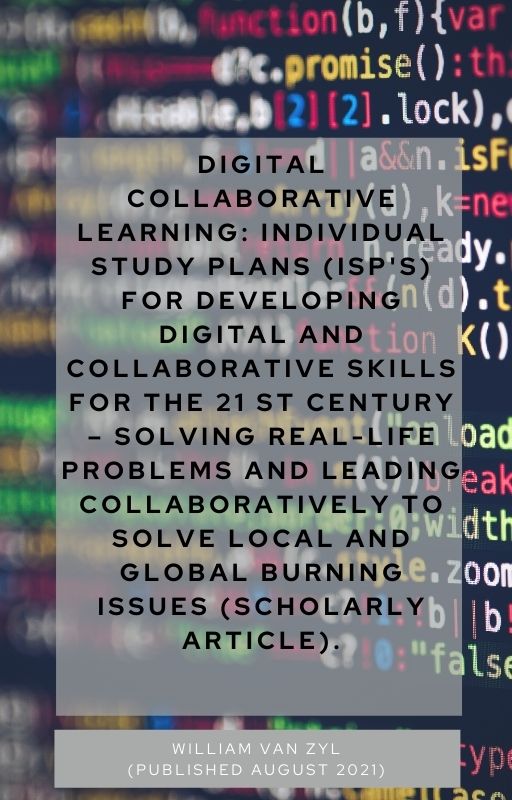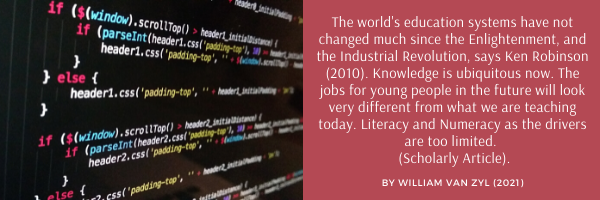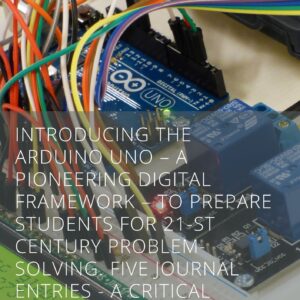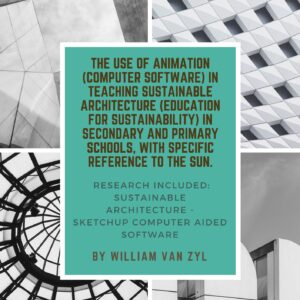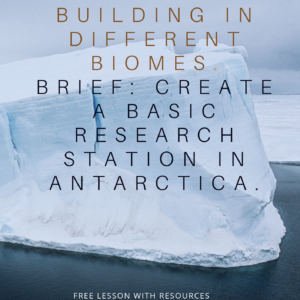$0.00
11 x size A4 pages. 2330 words. Several graphs/diagrams/lists are included (21 st Century Learning skills).
ABSTRACT:
An interesting scenario is included in the abstract. Please read the blog post to find out more.
Here is the first section of the SCENARIO:
Imagine – as a high school teacher – a new student walks through the door of your classroom. A folder is in her hand – a Personal Profile Folder labelled Career Path and Digital and Collaborative History: Jolene Hobson (Calambra College, New Zealand). You open the folder, and online access details are on the first page:
To see Jolene’s Career, Digital and Collaborative skills history, please follow this link. Request access from the local Education Department…….. (go to the blog post).
SYNOPSIS
After identifying the skills required for the 21 st Century, this scholarly paper will not look at the possibilities for embedding digital and collaborative skills into subject areas. On the contrary, it will be focusing on an individual approach (ISP’s) for learning in the 21 st Century. This article will explore the implementation of Individual Study Programs (ISP’s) for individual students in a collaborative context developing digital skills.
References
Fadel, C. (2008). 21st Century Skills: How can you prepare students for the new Global Economy? Partnership for 21st Century Skills. https://www.oecd.org/site/educeri21st/40756908.pdf
Global Partnership for Education (2020). UNESCO. 21st Century Skills: What potential role for the Global Partnership for Education? A Landscape Review. https://www.globalpartnership.org/sites/default/files/document/file/2020-01-GPE-21-century-skills-report.pdf
Pellegrino, J.W. & Hilton, M.L. – Editors (2012). Committee on Defining Deeper Learning and 21st Century Skills; Center for Education; Division on Behavioral and Social Sciences and Education; National Research Council. Retrieved from https://hewlett.org/wp-content/uploads/2016/08/Education_for_Life_and_Work.pdf
OECD (Organisation for Economic Co-operation and Development) (n.d.). “The Future of Education and Skills.” Last modified 2018.
Prensky, M. (2007). Changing Paradigms from “being taught” to “learning on your own with guidance.” Published in Educational Technology, July-Aug, 2007. http://hibgroupbpr.pbworks.com/f/Prensy’s+Changing+Paradigms.pdf
Parsons, D. (2021). 21st Century Skills Frameworks [Video]. Uploaded in July 2021 by The Mindlab (UNITEC – New Zealand).
Robinson, K. (2010, October 14). RSA ANIMATE: Changing Education Paradigms [Video]. YouTube. https://youtu.be/zDZFcDGpL4U
Southwest Charlotte STEM Academy (SCSA) (n.d.). https://scstemacademy.org/4-cs-of-21st-century-skills/
Spencer, J. (2017, June, 10). The Shift from Engaging Students to Empowering Learners [Video]. YouTube. https://youtu.be/BYBJQ5rIFjA
World Economic Forum (n.d.). 21 st Century skills: Future Jobs for Students. https://www.weforum.org/agenda/2016/03/21st-century-skills-future-jobs-students/ *Can filter website from 2005 to 2021.
Description
Read the article as a blog post for free:
https://fivehousepublishing.com/2021/08/21/digital-collaborative-learning-individual-study-plans-isps-for-developing-digital-and-collaborative-skills-for-the-21-st-century-solving-real-life-problems-and-leading-collaboratively-t/
ABSTRACT:
This scholarly paper will not look at the possibilities for embedding digital and collaborative skills into subject areas. On the contrary, it will be focusing on an individual approach (ISP’s) for learning in the 21 st Century. This article will explore the implementation of Individual Study Programs (ISP’s) for individual students in a collaborative context developing digital collaborative skills.
The paper starts with a scenario – touching on digital collaborative frameworks for the 21 st Century- and then focuses on Individual Study Plans (ISP’s) for high school students.
EXCERPT:
Individual Study Plans (ISP’s) for students.
Spencer (2017) and Robinson (2010) comment on the shifts required from what students have to learn to what do they want to learn. It’s a shift from the teacher asking all the questions to the students asking their own questions, exploring what they find interesting. They could consider the inquiry process and take their learning journey where they want to go.
It is moving away from uncritical consuming to consciously taking a critical consuming and creating perspective. It is shifting away from instruction that is differentiated to more tailor-made personalised learning. (Core Education; 2017).
And also, it is moving away from fixed to more pliable systems. Students should own the process. It is important that students are able to choose their own pace. They should be able to choose their own strategy (choosing their own formats), and they should be able to decide what sources and resources they want to explore to reach their goals (Van Zyl, 2021).
Such a mindset – where compliance is required – should allow ownership and self-direction. For example, Individual Study Plans – ISP’S (Van Zyl, 2021). In other words, the student owns his/her choices and strategies. When that happens, our students could become creative, critical thinkers, and innovators that could impact the world.
Shouldn’t we have done this 10 to 20 years ago? Change the ‘production line’ conveyor belt paradigm – Robinson (2010) – to an individually tailor-made learning plan for every student (Spencer 2017)?
The top 10 skills identified by the U.S. National Research Council (2020).
The consensus among different organisations on the framework for 21 st century skills.
We have already completed 20% of the 21 st century. Should we still talk about planning for this Century? However, it is still relevant because it reflects dimensions of human competence (U.S. National Research Council, 2020).
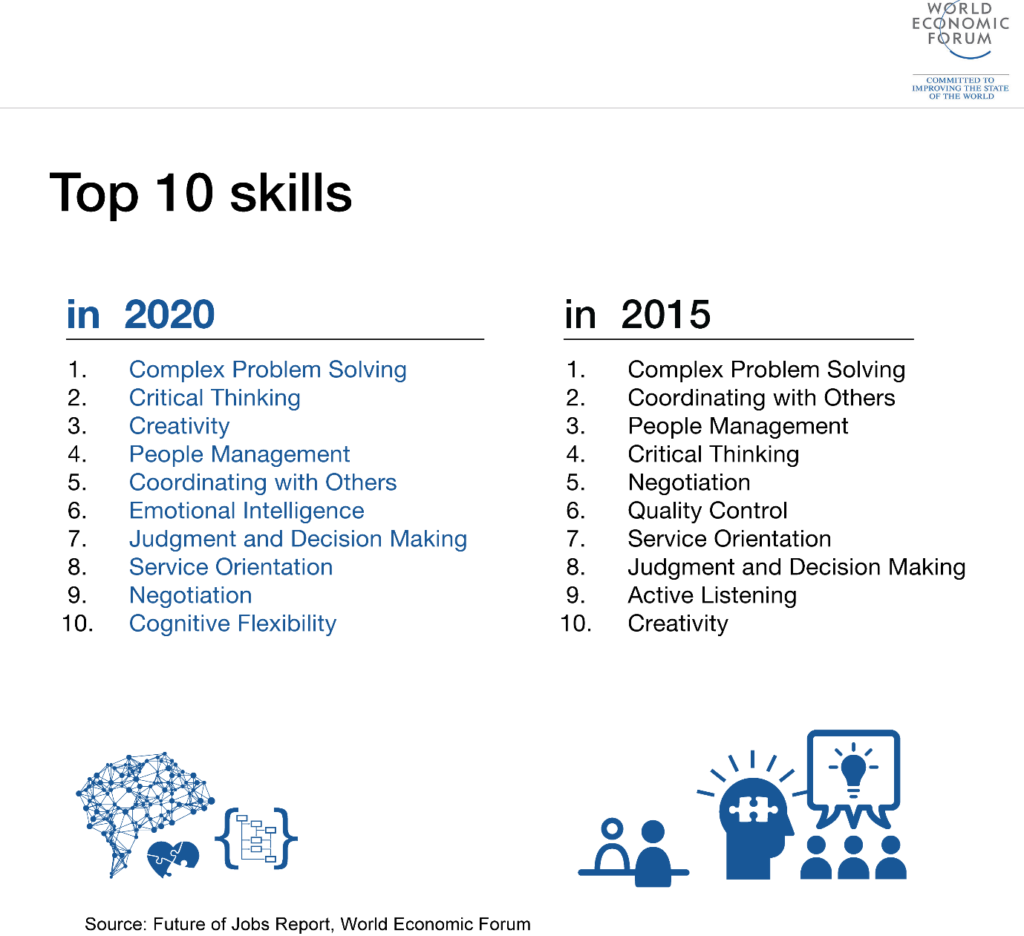
Source: World Economic Forum (2020).
Analysing the data of the Top 10 Skills: Comparing 2015 with 2020. See the shift in the last 5 years (2015 to 2020). See how critical thinking moved to position 2 (vertical migration). Creativity and innovation are in position 3. Are schools ready to teach Solving Complex Problems? To what extent are digital technology used – in a collaborative context – in schools in N.Z. and around the world? Could Google Docs be developed to improve collaboration? For example, prompts that teach how to improve Peer-to-Peer learning and collaboration (short instructional videos on Google Drive). The comparative lists below from the World Economic Forum shows the top skills listed for 2015 and 2010.
When analysing the two lists, it is clear that much has changed in 5 years. Critical thinking and creativity had migrated up towards the top (2020). To get students passionately involved, we have to know their strengths, their weaknesses and their passions. With this valuable information, the teacher can plan specific lessons for groups of students and use documented knowledge (past experiences of students) to combine certain students for particular tasks. Peer-to-Peer collaboration, Peer Learning and Peer Assisted Learning are concepts that required expertise and experience to successfully implement and integrate into the classroom (digital context and face-to-face). See the article The Disadvantages of P2P Collaboration: https://fivehousepublishing.com/product/p2p-collaboration-the-disadvantages-of-p2p-peer-to-peer-collaboration-pal-peer-assisted-learning-and-pl-peer-learning-2/.
Some students may have a passion for writing code, others prefer the electronics side, some could be scientists, some could be mathematicians, and so on. Teachers will be able to create ISP’s for students individually as well as select a range of students that will fit best for the task.
